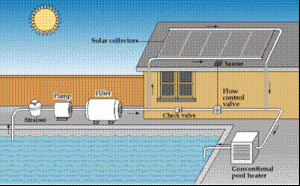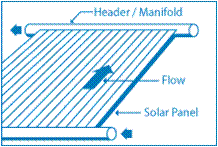Solar pool heaters can significantly reduce swimming pool heating costs. They are competitive with with both gas and heat pump pool heaters, and they have very low annual operating costs. In some climates they are the most cost efficient.
HOW THEY WORK
Most solar pool heating systems include a solar collector, a filter, a pump and a flow control valve. A functional description of each is described below.
- A solar collector — the device through which pool water is circulated to be heated by the sun
- A filter — removes debris before water is pumped through the collector
- A pump — circulates water through the filter and collector and back to the pool
- A flow control valve — automatic or manual device that diverts pool water through the solar collector.
The pump directs the pool water through the filter and then through the solar collector(s). The collector heats the water and returns it to the pool. In very hot climates, using the collector(s) at night can cool the pool.
The sophistication of solar systems vary and may include sensors and automatic controls to increase or divert the flow as needed to maintain the temperature of the pool. The sensors direct the flow and when the collector temperature is similar to the pool temperature, filtered water simply bypasses the collector(s) and is returned to the pool.
The Solar pool collectors come in many forms and are made out of different materials depending on their use. If they are used only when temperatures are above freezing, then you may only need an unglazed collector system. Unglazed collectors are generally made of heavy-duty rubber or plastic treated with an ultraviolet (UV) light inhibitor to extend the life of the panels. Because of their simple design and inexpensive parts, unglazed collectors are less expensive than glazed collectors. The unglazed systems work for indoor pools in cold climates if the system is designed to drain back to the pool when not in use. Even if you have to shut the system down during cold weather, unglazed collectors may be more cost effective than installing a more expensive glazed collector system.
Example of how a solar collector works.
Glazed collector systems are generally made of copper tubing on an aluminum plate with an iron-tempered glass covering, which increases their cost. In colder weather, glazed collector systems—with heat exchangers and transfer fluids—capture solar heat more efficiently than unglazed systems. Glazed collectors may be used year round in many climates for pools and to heat water for domestic use. Galzed and Unglazed collectors should be equipped with freeze protection if used in cold climates.
Interesting DIY Solar Pool Heater Video

